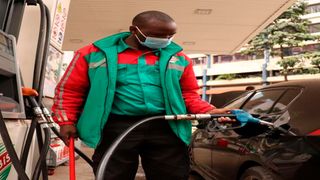
A pump attendant serves a customer on August 14, 2021 at Rubis petrol station on Koinange Street in Nairobi. Fuel prices remain unchanged in the latest revision by Epra.
| Dennis Onsongo | Nation Media GroupBusiness
Premium
Nairobi pump pain: Puzzle of cheaper fuel in Nakuru
What you need to know:
- Pricing formula is expected to make commodity more expensive as one travels farther away from Mombasa.
- All towns on the west of Nairobi are expected to be more expensive due to the transportation costs.
It cheaper to buy fuel in Nakuru, Naivasha, Gilgil, Nyahururu, Mogotii and Londiani than it is in Nairobi, in yet another puzzle that continues to baffle many motorists given that it goes against the stated principles of the fuel pricing formula.
The formula is expected to make fuel more expensive as one travels further away from Mombasa, as it factors in the cost of transportation.
So all towns on the west of Nairobi are expected to be more expensive due to the transportation costs.
But consumers continue to wonder why it would be cheaper to buy fuel in Nakuru than it is in Nairobi despite being transported for a further 170 kilometers from the capital.
In Nairobi, consumers will buy petrol at Sh127.14 per litre, diesel (Sh107.66) while kerosene will retail at Sh97.85.
Nakuru motorists are the happiest west of Nairobi given that a litre of petrol for another month will cost Sh126.75, diesel (Sh107.55) while Kerosene will cost Sh97.76 per litre.
In keeping with the formula, Mombasa consumers will remain the happiest nationally with, super petrol retailing at Sh124.72, diesel (Sh105.27) and kerosene (Sh95.46).
Storage and distribution, which includes the transport element, takes Sh3.17 per litre of super petrol, diesel (Sh2.9) while kerosene attracts Sh2.88. The costs include pipeline and depot losses as well as delivery within 40kms of Nairobi.
Biggest puzzle
But the biggest puzzle is the new found headroom for manoeuvring by the Energy and Petroleum Regulatory Authority (Epra), which now routinely gives prices that deviate from the direction of the global oil prices and the actual landed costs — raising the questions on whether Kenyans are being denied better prices of the commodity.
Over the weekend, consumers sighed in relief after Epra held steady current fuel prices for another month in its monthly reviews, despite increases in landed costs.
Announcing the decision on Saturday, Epra said retail prices of petroleum products, which will be in force from August 15 to September 14, 2021, will remain unchanged.
“The prices are inclusive of the 8 percent Value Added Tax (VAT)… and the revised rates for excise duty adjusted for inflation as per legal notice no 194 of 2020,” Epra Director-General Daniel Kiptoo said in a statement.
The average landed cost of imported super petrol increased by 6.21 percent from $520.04 (Sh56,680) per cubic metre in June 2021 to $552.35 (Sh60,206) per cubic metre in July 2021.
The landed cost of diesel increased by 7.36 percent from $479.01 (Sh52,211) per cubic metre to $514.24 (Sh56,053).
But it is the landed cost kerosene that recorded the highest spike of 9.81 percent from $449.37 (Sh48,981) per cubic metre to $493.45 (Sh53,786) per cubic metre.
The main considerations for what Kenyans pay for fuel include landed costs, taxes, dealer margins and the exchange rate.
This is why it is difficult to compare Kenya with another country since these factors are not the same.
Heavy taxes
Also, Kenya imports refined oil, which does not always go in the direction of crude, or delays in reflecting, as refineries factor in their margins.
In July the Lifted Free on Board (FOB) price of Murban crude oil stood at $66.7 (Sh7,136) per barrel, an increase of 5.29 percent, from $63.35 (Sh6,905) per barrel in June 2021.
July’s crude is now at the second highest price in the last 12 months, with May being the most expensive at $66.71 per barrel.
Over the same period, the Kenya shilling exchange rate depreciated by 0.41 percent from Sh107.8 per greenback to Sh108.26 for every dollar in July 2021.
“The purpose of the petroleum pricing regulations is to cap the retail prices of petroleum products which are already in the country so that importation and other prudently incurred costs are recovered while ensuring reasonable prices to consumers,” Mr Kiptoo said.
The Epra boss said his agency wishes to assure the public of its continued commitment to the observance of fair competition and protection of the interests of both consumers and investors in the energy and petroleum sectors.
An analysis by the Nation on the trend of fuel prices reveals that Kenya’s motorists are disadvantaged against their peers in the region due to the heavy taxes that Kenyans have to pay.
The taxes in Kenya make fuel cheaper in Kampala and other cities in the east African region, despite the oil being transported through Kenya after arriving at the same landed costs.
Pump prices
For instance, in the new prices for this month, the landed cost for a litre of super petrol is Sh60.76.
But consumers will pay double this amount when they go to fuel at any pump.
This is the same for diesel and kerosene, which landed at Sh56.32 and Sh53.86 per litre, respectively.
The fuel at the pumps doubles to over Sh124 per litre when Epra starts loading them with taxes and other fees.
Another cost is supplier margins, which now stand at Sh5.29 per litre of petrol, Sh2.47 per litre of diesel and Sh1 per litre of kerosene.
Then about nine different taxes and levies hit the landed cost.
In total, as you buy a litre of petrol, taxes and levies will take Sh58.22, diesel (Sh45.97) and kerosene (Sh40.11).
This is how the pump prices for petrol for instance move from Sh60.46 landed cost to Sh127.14 in Nairobi.





